Exploring Common Types of Cable Ties Used in Network Infrastructure
July 30, 2025
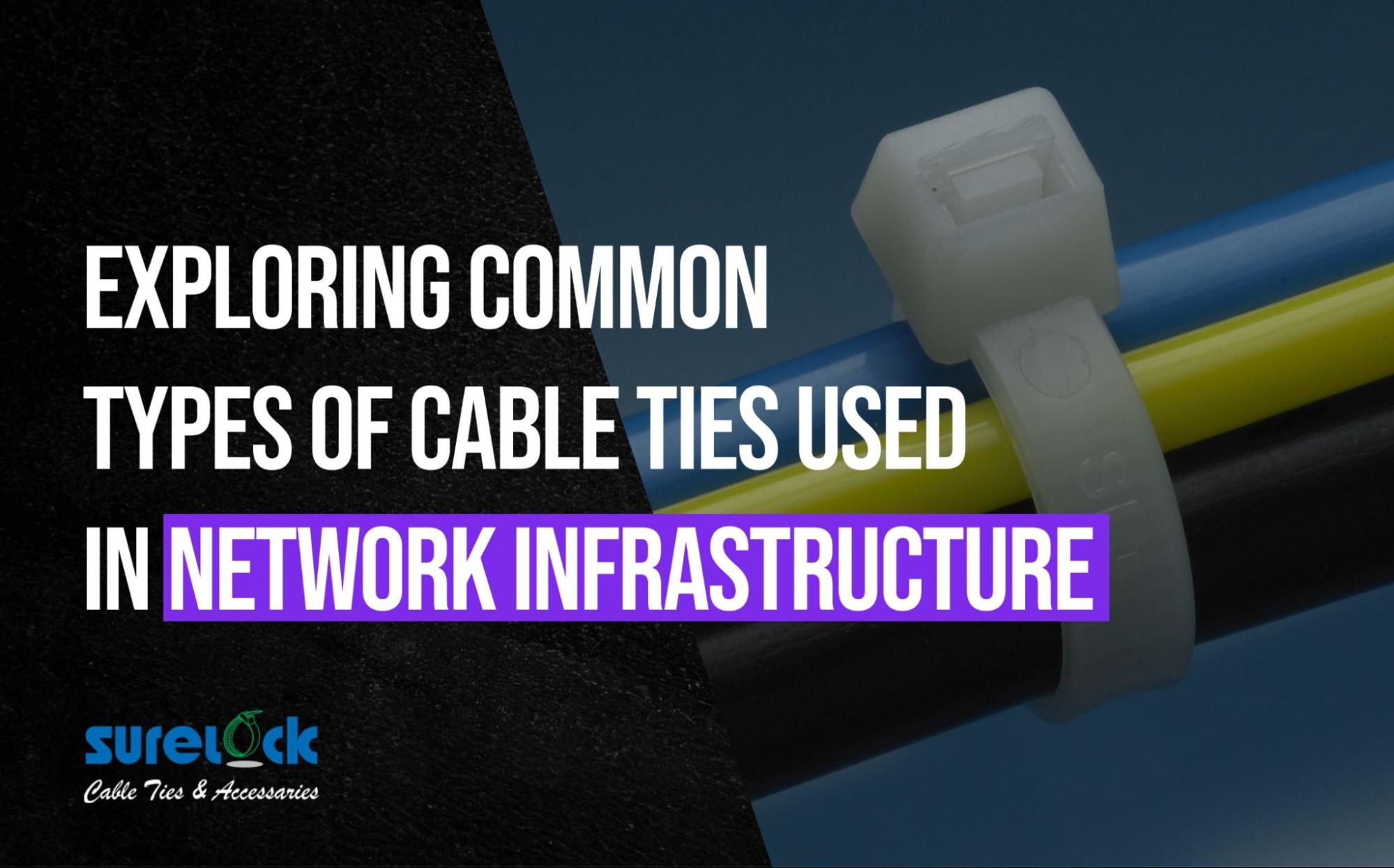
Is your network infrastructure at risk because cables aren’t properly secured and managed? Poorly organized cables can lead to serious system disruptions, downtime, and costly repairs. We understand the challenges that network managers, IT professionals, and infrastructure teams face when cables are tangled, misrouted, or improperly secured.
But there’s an easy fix. By using the right types of cable ties, you can ensure that your networking infrastructure runs smoothly and efficiently, minimizing disruptions and maximizing uptime.
In this blog, we’ll explore the types of cable ties commonly used in networking infrastructure, how to select the best cable tie for your needs, and best practices for installation. Whether you’re a seasoned professional or new to cable management, this guide will help you secure your cables, improve system reliability, and save time on maintenance.
TL;DR - Key Takeaways
- Cable ties are essential for securing and organizing network cables, ensuring efficiency and preventing interference.
- The right type of tie, whether releasable, tag ties, or double loop, depends on specific networking needs.
- Proper installation and spacing prevent cable damage, ensuring longevity and minimizing downtime.
- Reusable ties reduce waste, supporting a sustainable approach to cable management.
What Are Cable Ties?
Cable ties, often known as zip ties, are simple yet highly effective fastening devices used to bundle and organize cables and wires. Made from durable materials like nylon, they are designed to secure cables tightly and prevent them from tangling or becoming damaged.
With their simple, adjustable mechanism, cable ties are a versatile solution used in various industries, especially in networking infrastructure, to ensure a neat, safe, and efficient wiring system. Here’s why cable ties are essential in networking installations:
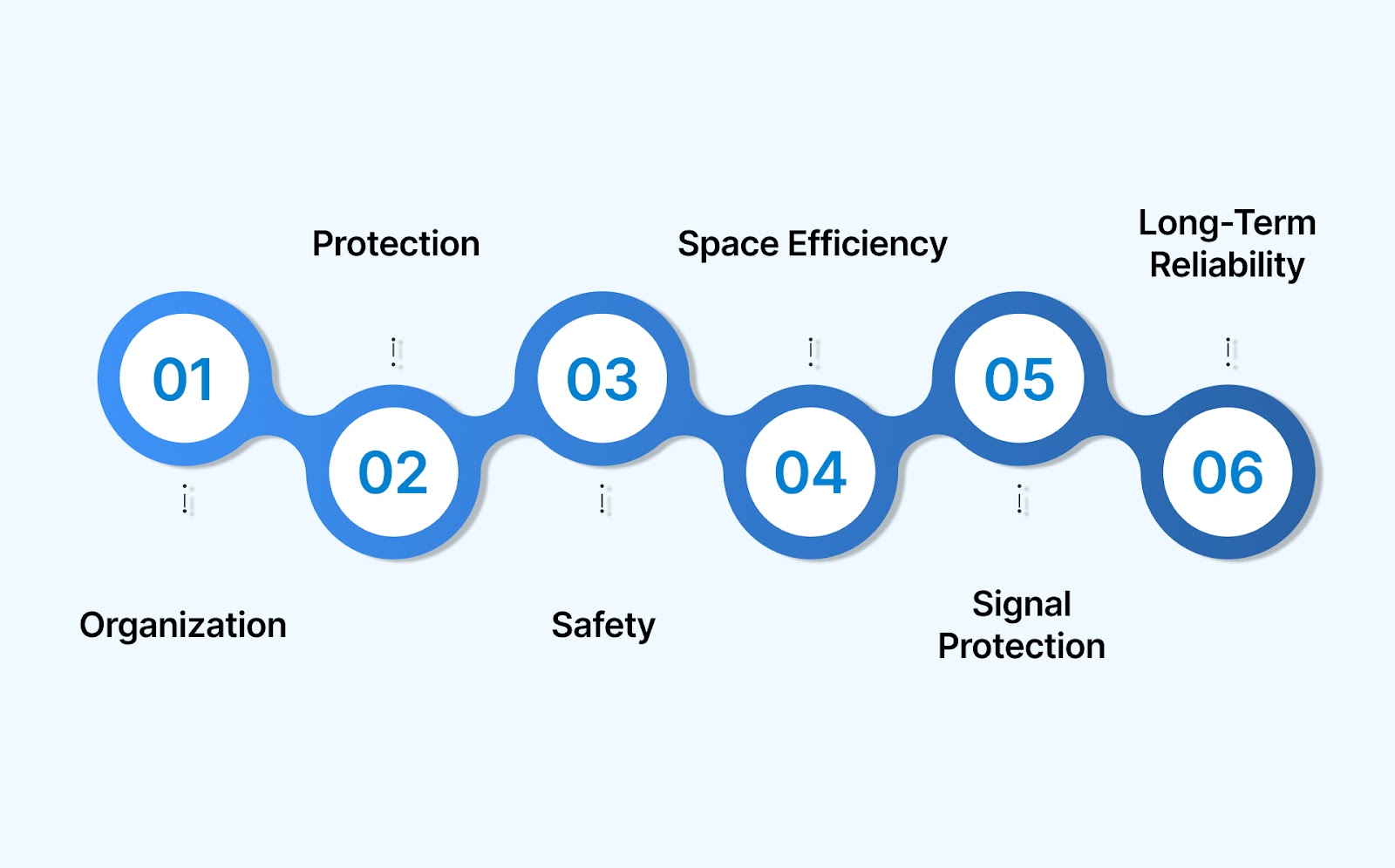
- Organization: Cable ties help neatly bundle cables together, reducing clutter and ensuring easy access when troubleshooting or upgrading is needed.
- Protection: Securing cables prevents them from being exposed to wear, tear, and physical damage, which can disrupt network performance and reliability.
- Safety: Properly secured cables minimize the risk of tripping hazards or interference with other equipment, maintaining a safe working environment.
- Space Efficiency: With their ability to bundle cables tightly, cable ties help optimize space within server racks, thereby reducing the infrastructure's footprint.
- Prevention of Signal Interference: Organized cables are less likely to cross or interfere with one another, ensuring that the signal transmission remains clear and uninterrupted.
- Long-Term Reliability: Cable ties ensure that cables stay securely in place, reducing the need for frequent maintenance and preventing downtime due to cable disconnections or failures.
Now that we understand what cable ties are and their importance, let’s delve into the main types used in networking projects and explore how each type serves a distinct purpose.
Main Types of Cable Ties Used in Networking Infrastructure
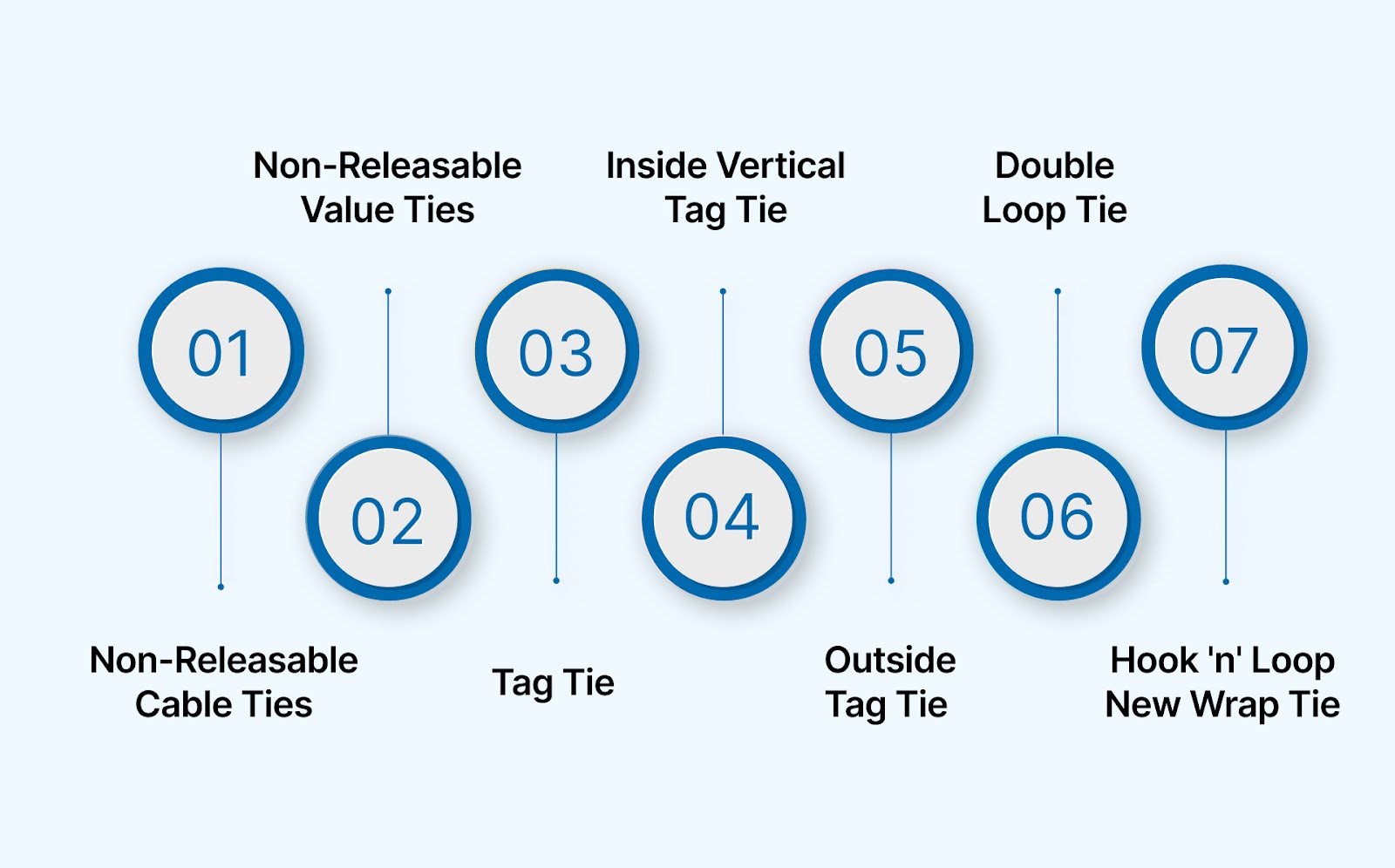
In networking infrastructure, selecting the right type of cable tie is crucial for ensuring secure and efficient cable management. Below are the main types of cable ties used in networking settings, each tailored to meet specific needs for protection, organization, and flexibility.
1. Non-Releasable Cable Ties
These cable ties are used for bundling and securing cables permanently. They offer a simple and effective method for organizing and managing cables.
- Material: Nylon 66
- Operating Temperature: −40°C to +85°C
- Features:
- They are an economical and versatile method of cable/ wire bunching system
- It has self-locking and one-piece construction, which ensures fast and easy installation
- Non-Releasable Cable Tie, once locked, cannot be opened or reused
2. Non-Releasable Value Series Cable Ties
These cable ties are used for indoor wire and cable bundling and packaging of bags. It offers a cost-effective and efficient solution for various bundling needs.
- Material: Nylon 66
- Operating Temperature: −40°C to +85°C
- Features:
- Low cost
- Economical design
- Uncompromised tensile strength
3. Tag Tie
Commonly used for tying and identifying cable bundles. It provides a practical solution for both organizations and clear labeling.
- Material: Nylon 66
- Operating Temperature: −40°C to +85°C
- Features:
- For simple identification and securing of cable bundles in one step
- Laser marking is possible as per the requirement
- Manual or temporary marking is possible with a marking pen
4. Inside Vertical Tag Tie
Commonly used for tying and identifying cable bundles. It offers a neat and efficient way to manage and distinguish various wiring.
- Material: Nylon 66
- Operating Temperature: −40°C to +85°C
- Features:
- For simple identification and securing of cable bundles in one step
- Laser marking is possible as per the requirement
- Manual or temporary marking is possible with a marking pen
5. Outside Tag Tie
Commonly used for tying and identifying cable bundles. It provides a convenient method for both organization and clear labeling in various applications.
- Material: Nylon 66
- Operating Temperature: −40°C to +85°C
- Features:
- For simple identification and securing of cable bundles in one step
- Laser marking is possible as per the requirement
- Manual or temporary marking is possible with a marking pen
6. Hook 'n' Loop New Wrap Tie (Back to Back)
For sensitive cable bunching, which doesn't require industrial strength. It provides a soft and reusable solution for organizing and securing cables.
- Material: Hook: Nylon-6 (PA-6) molded
- Material: Loop: Nylon-6 (PA-6) multifilament knitted
- Operating Temperature: −20°C to +85°C
- Feature:
- The slotted head ensures convenient application
At Surelock, we provide a diverse range of high-quality cable ties to suit every networking need. Whether you need non-releasable, releasable, or tag ties, our durable solutions ensure your cables are securely managed and protected for long-term performance. Explore our products and elevate your cable management today.
With a solid understanding of the different types of cable ties, let’s take a closer look at their real-world applications and see how they are put to use in networking systems.
Also read: Cable Ties for Electrical Installations: Types and Applications
Real-World Applications of Cable Ties in Network Infrastructure
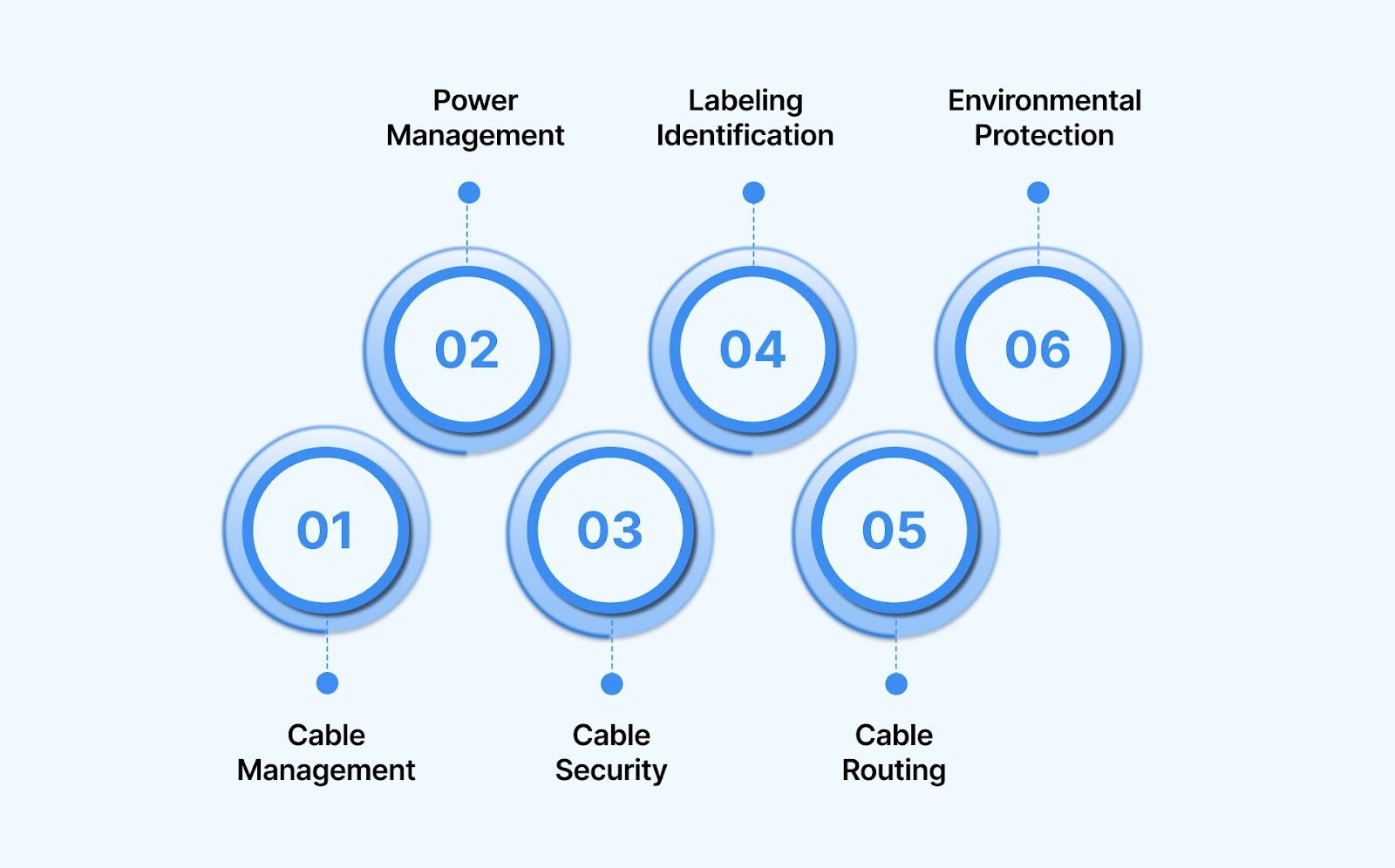
Cable ties are more than just simple tools for bundling cables; they play a crucial role in maintaining the efficiency, safety, and longevity of networking infrastructure. Below are practical examples of how cable ties are used across various stages of networking management:
- Cable Organization in Data Centers: Cable ties are used to neatly bundle and organize cables running through server racks, preventing tangling and ensuring easy access during maintenance.
- Managing Power Cables: In networking setups, cable ties secure power cables, keeping them out of the way and reducing clutter, while preventing accidental unplugging or disconnections.
- Securing Network Cables: For Ethernet, fiber optic, and coaxial cables, cable ties hold them in place to maintain signal integrity and avoid interference in high-speed networking environments.
- Labeling for Identification: Cable ties with integrated tags help label cables, making it easier to identify specific connections during troubleshooting and reducing the time spent on system repairs.
- Routing Cables in Tight Spaces: In confined areas, such as conduits or racks, cable ties secure cables in place, preventing unnecessary pressure on the cables and ensuring proper airflow.
- Protecting Against Environmental Factors: In outdoor or industrial environments, cable ties are used to protect cables from UV exposure, moisture, and temperature extremes, ensuring long-lasting performance.
By organizing, securing, and protecting cables, cable ties play an essential role in maintaining the integrity and efficiency of networking systems. Now that we’ve seen how cable ties are used in practice, it’s time to compare them with alternative fastening methods to understand which method is best suited.
Cable Ties vs. Alternative Fastening Methods
When it comes to securing cables, several methods are available, each offering unique benefits for different applications. Cable ties, clips, and clamps are the most common fastening solutions. Below, we compare these options to help you choose the right one for your network installation needs.
For networking systems, cable ties are ideal for bundling cables together, ensuring neatness and security. Let's explore how to select the right cable tie for your networking applications.
Also read: 10 Industrial Use Cases for Cable Ties
Guide to Selecting the Right Cable Tie for Networking Applications
Choosing the right cable tie is critical to ensuring your networking applications are organized, secure, and reliable. The perfect cable tie will provide the necessary support while accommodating the unique needs of your setup. Here are key considerations when selecting the right cable tie:
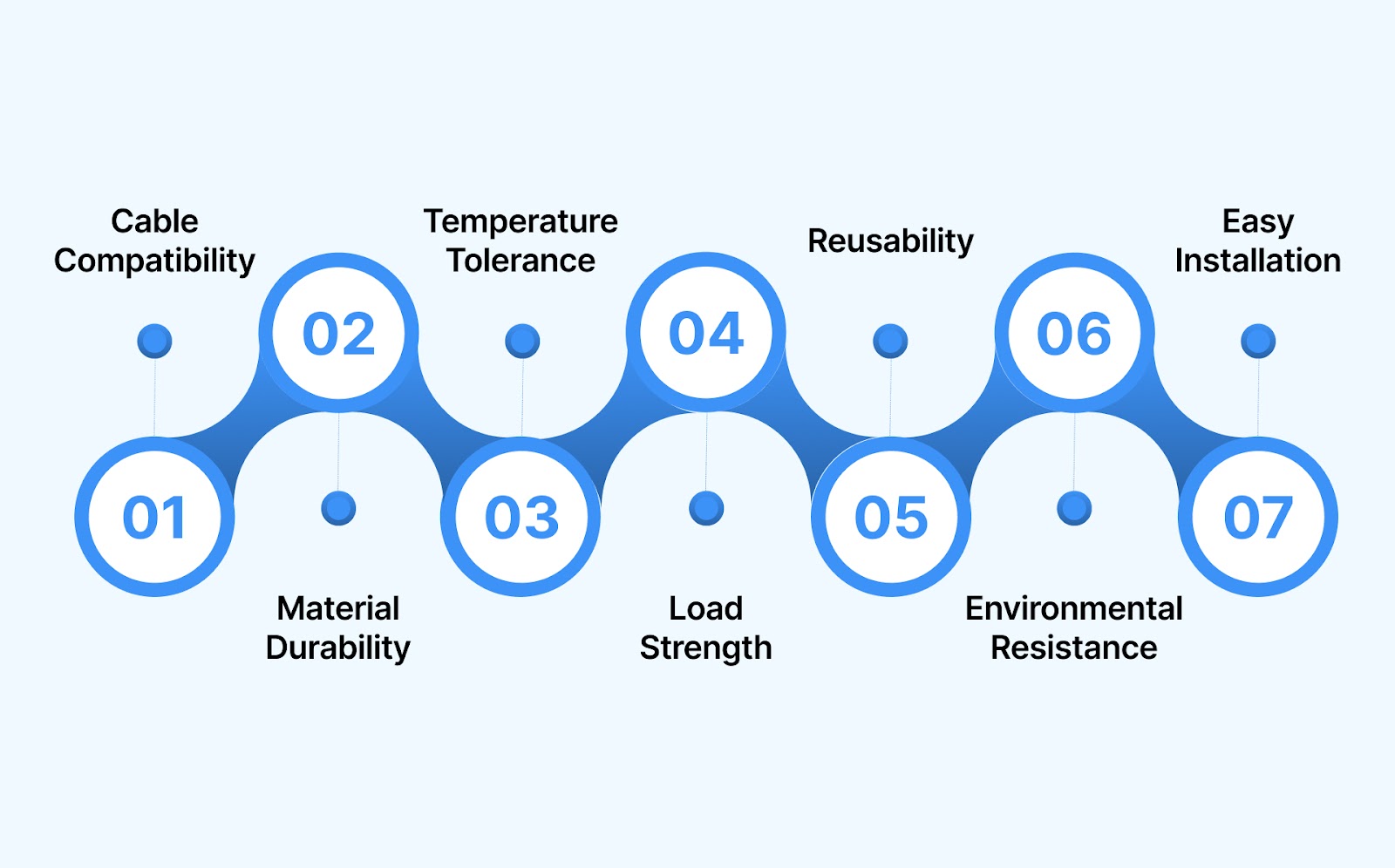
- Cable Size and Type: Choose a cable tie that matches the size of your cables. Too tight, and the cable may get damaged; too loose, and it won’t secure the bundle properly.
- Material Durability: Consider the environment where your cables will be used. Nylon ties are versatile and are ideal for different environmental conditions.
- Operating Temperature Range: Ensure the tie can withstand the operating temperature range of your networking equipment. Select ties that work within the temperature extremes to which your cables will be exposed.
- Strength and Load Capacity: If your cables are heavier or under more stress, choose a tie with higher tensile strength to prevent slippage and breakage.
- Reusability: If you need flexibility in re-routing or modifying cable bundles, opt for releasable cable ties. Non-releasable ties are better for permanent installations.
- Environmental Resistance: For installations in outdoor or harsh environments, select ties with added resistance to UV rays, moisture, and chemicals to prevent degradation over time.
- Ease of Installation: Some cable ties come with integrated locking mechanisms or pre-applied adhesive mounts for quick and easy setup. Choose what suits your workflow best.
Surelock provides an extensive range of cable ties, clips, clamps, and wiring accessories, designed to suit various industries and applications. Explore our collection and discover the ideal solution for your networking projects today.
Having the right cable tie is crucial, but using it properly is just as important. Let’s discuss the top best practices for securing your cables effectively in networking systems.
Top Best Practices for Using Cable Ties in Network Systems
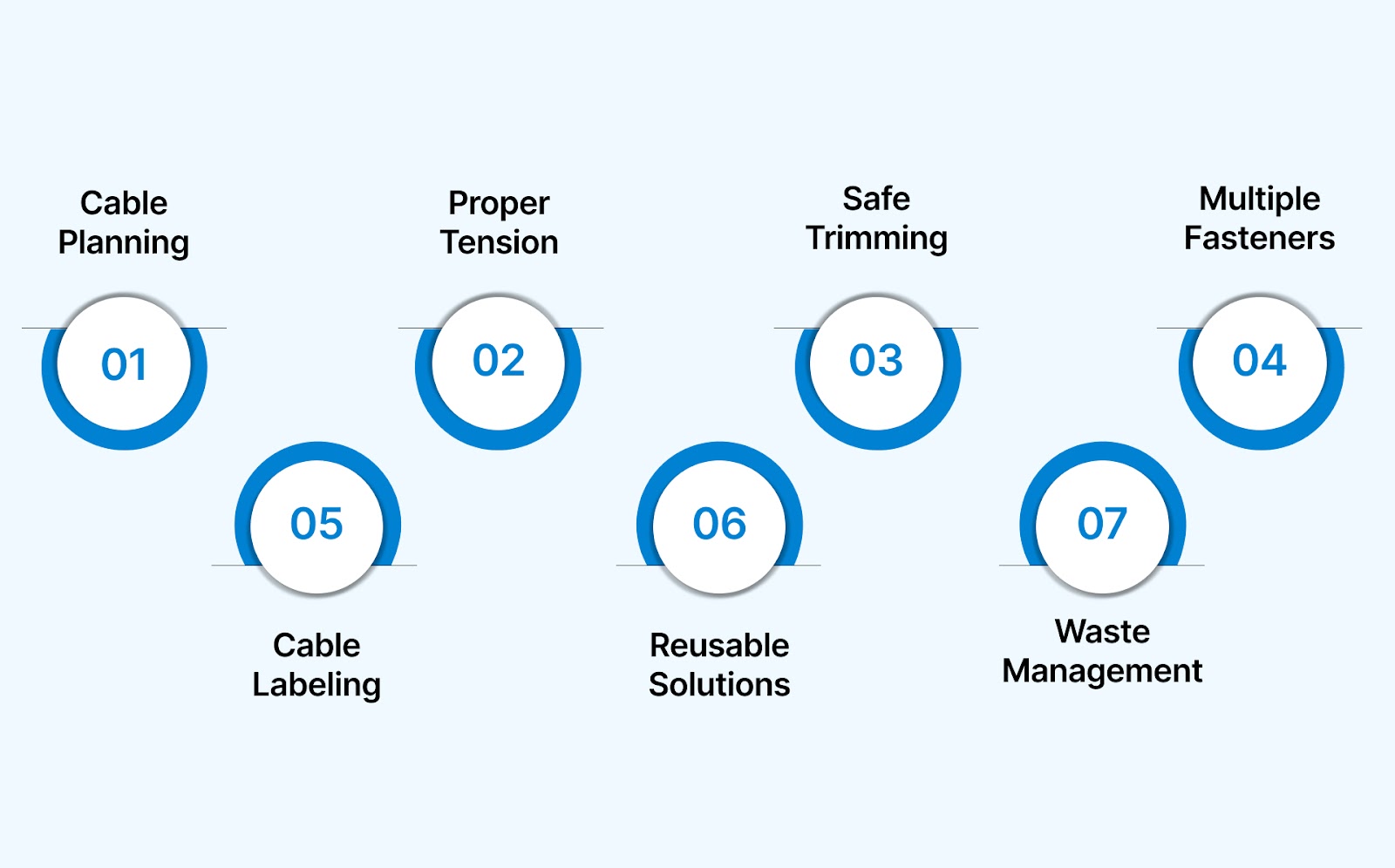
Using cable ties effectively ensures that your network infrastructure remains organized, safe, and efficient. By following proper techniques and considering environmental factors, you can maintain a well-functioning, sustainable networking system. Here are key practices to keep in mind:
- Organize and Plan Cable Routing First: Before securing cables, group related cables and plan the layout. Separate high-voltage cables from low-voltage or data cables to minimize interference and ensure compliance with safety codes.
- Apply the Right Amount of Tension: Tighten the cable tie to hold the cables securely, but avoid over-tightening. Excessive tension can damage cables, particularly those that are delicate, such as fiber optics or electrical wires.
- Trim Excess Tie Length Safely: Once the tie is secure, trim the excess tail carefully to avoid sharp edges that could damage nearby cables or cause injury.
- Use Multiple Ties for Longer Runs: For longer cable runs, don’t rely on a single tie. Use several ties spaced at intervals to provide consistent support and prevent cables from sagging.
- Label Your Cables for Easy Management: Use labeled ties or color-coded ones to mark cables for easy identification during maintenance or troubleshooting, saving you time and effort.
- Reducing Waste with Reusable Options: To minimize waste, consider using reusable cable ties for projects that require regular adjustments. This approach helps reduce the use of single-use plastics and their environmental impact.
- Proper Disposal Practices: When trimming or removing cable ties, it's crucial to dispose of the cut-off ends properly. Loose tie ends can pose risks to wildlife and the environment. Collect and dispose of them responsibly, ensuring minimal harm to pets and the environment.
By adhering to these best practices, you ensure the longevity and efficiency of your networking installations while also considering the environmental impact of your cable management choices.
Conclusion
Understanding the different types of cable ties and their applications is essential for maintaining a well-organized, secure, and efficient networking infrastructure. From bundling cables to ensuring long-term protection, the right cable tie can make all the difference in optimizing your network’s performance.
At Surelock, we offer a wide range of cable management solutions tailored to meet the specific needs of your infrastructure. Our products, including non-releasable cable ties, tag ties, and releasable cable ties, are designed to provide superior durability, flexibility, and reliability for any networking setup.
Contact us to explore our premium range of cable ties.
Frequently Asked Questions
1. What are the different types of cable ties?
Cable ties come in various types, including non-releasable, releasable, tag ties, double loop ties, and hook-and-loop ties, each suited for different bundling, labeling, or securing needs in networking systems.
2. How do I choose the right cable tie for my network?
Consider factors such as cable size, environmental conditions, material durability, and whether reusability is needed. Select a tie that fits your cable bundle securely without being too tight.
3. Can cable ties be reused?
Some types of cable ties, like releasable ties, can be reused. These are ideal for applications where cables need frequent adjustments.
4. Are cable ties safe for use in outdoor environments?
Yes, UV-resistant cable ties are specifically designed for outdoor use, offering protection against sunlight, weather, and temperature extremes to ensure long-term performance.
5. How should I dispose of cable ties properly?
To minimize environmental impact, ensure that cable ties are disposed of in accordance with local recycling guidelines. Consider using recyclable options to minimize environmental harm further.



